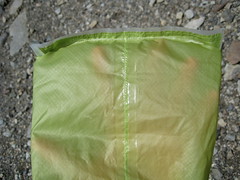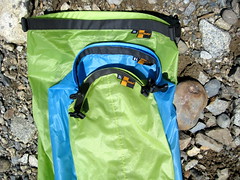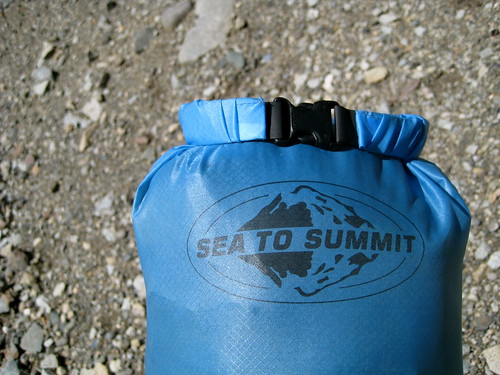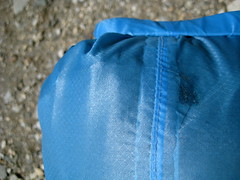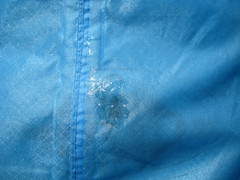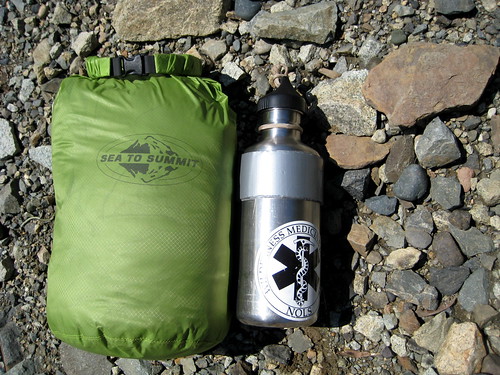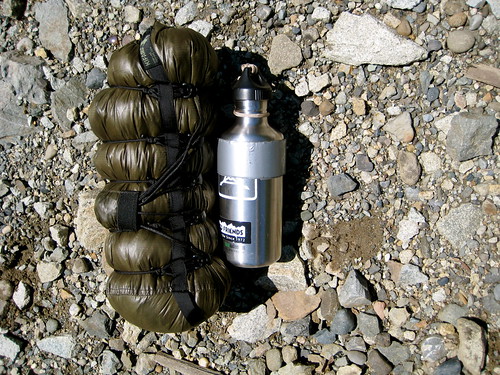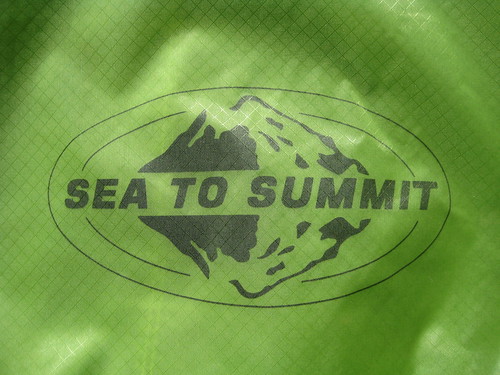Sea to Summit Ultra-Sil Dry Sacks
I love my Sea To Summit Ultra-Sil Dry Sacks. They’re made out of a thin and slippery silnylon Cordura, which makes them tough, light, and easy to slide in and out of a pack. The Hypalon roll top closure means no water can get in or out. All the seams are double stitched and taped on the inside. In all, the Ultra-Sil sacks are some of the lightest weight dry bags out there that still maintain a good level of durability. I’ve had an 8 liter and 2 liter model for about three years. Last Fall, I picked up a 13 liter model.
8L Ultra-Sil
The 8 liter model is my most used bag. I use it primarily to carry clothing. For me, it’s the perfect size for 3 season use. During the winter, when I’m carrying more puffy clothing, I sometimes have to supplement it with a secondary sack. I’ve had the whole thing accidentally submerged multiple times and never came out with wet contents.
The 8 liter sack also functions as my pillow at night. This is a bit tough on the sack, since as a pillow it normally sits directly on the ground above my sleeping pad and so gets rubbed around on the dirt and rocks. In the 3 years that I’ve used it as a pillow, I’ve only ever had one failure – and that one just after this last trip. There was a small abrasion near the seam in the middle of the bag that I noticed dripping water when I was cleaning the bag. A dab of Mcnet Silnet on the inside and the outside of the bag sealed that right up and the sack is once again waterproof.
2L Ultra-Sil
The smaller 2 liter bag has seen a variety of duties. It’s held a first aid kit, notes, and small clothing items like gloves and a hat. For the past 6 months it has functioned as my camera case. You may remember that back when I did an EDC post I mentioned in the photo notes for my level 2 items that I wrapped my camera in a bandanna for padding and then put that in a waterproof Aloksak. The problem with that setup is that Aloksaks aren’t incredibly durable, nor are they cheap. I can’t afford to replace them every time they fail. So I moved to putting the bandanna-wrapped camera in the 2 liter Ultra-Sil sack. It’s just as waterproof (if not more so), but also more durable. The other benefit to using the Ultra-Sil is that I have plenty of room left over in the sack to dump in my cell phone when traveling in the wilderness.
13L Ultra-Sil
The 13 liter Ultra-Sil I bought last Fall to hold my sleeping bag. Prior to this I used a Kifaru Compression Stuff Sack. The Kifaru sacks are great at compressing bulky items down. Patrick developed them to compress around the circumference of the item, rather than length wise, so that they actually fit in the bottom of a pack (strangely enough, a novel idea). They’re made of a lightweight and waterproof material, but only close with a drawstring closure. This means that water can potentially creep inside. I’ve used one of these sacks in some capacity since 2007 and never once had an item get wet, but it’s always a risk. The other issue for me is that I rarely ever max out the capacity of my pack. I can afford the space for bulky items and don’t need to compress them. So I decided to start using the Ultra-Sil sack for my sleeping bag. They don’t compress, but they guarantee that my sleeping bag will always stay dry and, due to the lack of compression straps, the Ultra-Sils are lighter than the Kifaru sacks. (The small Kifaru compression sack – which I use for both my 20F bag and my 40F bag – weighs 68 grams, or 2.4 oz.) The 13 liter is a good size for my 20F bag. The 8 liter is a better size for my 40F bag, but because I only have one 8 liter sack and it’s always used for clothing, I usually end up using the 13 liter sack when carrying my 40F bag as well.
The only thing that I don’t like about the Ultra-Sil sacks is lack of a grab handle on the bottom. When I stuff my sleeping bag into the sack and purge out the air, it gets packed in there pretty well. To remove it I have to hold the bottom of the sack. Since there’s no grab loop, that means that I have to pinch the bottom, which also means pinching the sleeping bag itself. It’s not a big deal, but a grab loop on the bottom would make removing the sleeping bag ever-so-slightly easier.
If you’re looking to keep gear dry without a large penalty in weight, I would strongly recommend picking up two or three of the Ultra-Sil Dry Sacks.
Weight
- 2 L Ultra-Sil
- 20 grams / 0.7 oz
- 8 L Ultra-Sil
- 30 grams / 1 oz
- 13 Ultra-Sil
- 42 grams / 1.5 oz

